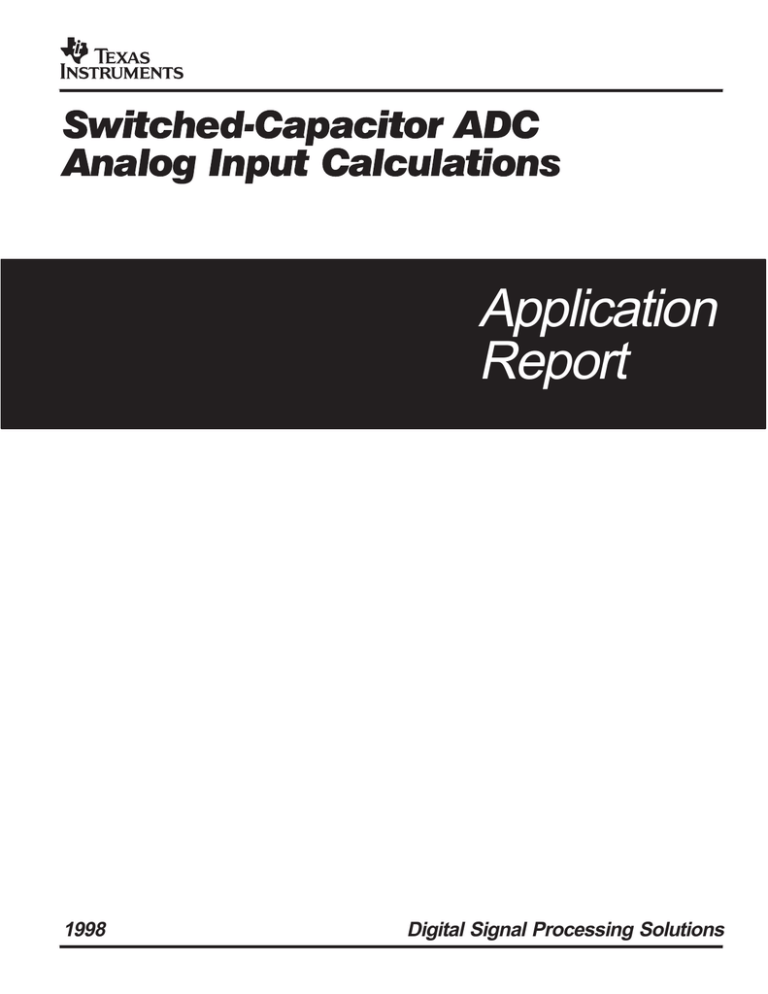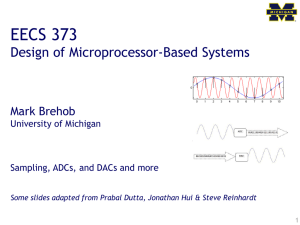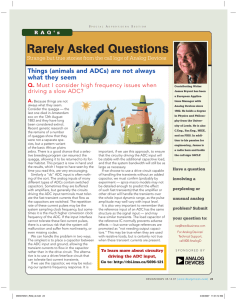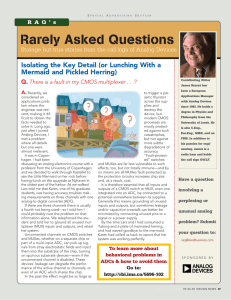switched-capacitor adc analog input calculations
advertisement

SwitchedĆCapacitor ADC Analog Input Calculations Application Report 1998 Digital Signal Processing Solutions Printed in U.S.A. 09/98 SLAA036 Switched-Capacitor ADC Analog Input Calculations Application Report Tom Kugelstadt Advanced Analog Products Advanced Analog Applications Group Literature Number: SLAA036 September 1998 Printed on Recycled Paper IMPORTANT NOTICE Texas Instruments and its subsidiaries (TI) reserve the right to make changes to their products or to discontinue any product or service without notice, and advise customers to obtain the latest version of relevant information to verify, before placing orders, that information being relied on is current and complete. All products are sold subject to the terms and conditions of sale supplied at the time of order acknowledgement, including those pertaining to warranty, patent infringement, and limitation of liability. TI warrants performance of its semiconductor products to the specifications applicable at the time of sale in accordance with TI’s standard warranty. Testing and other quality control techniques are utilized to the extent TI deems necessary to support this warranty. Specific testing of all parameters of each device is not necessarily performed, except those mandated by government requirements. CERTAIN APPLICATIONS USING SEMICONDUCTOR PRODUCTS MAY INVOLVE POTENTIAL RISKS OF DEATH, PERSONAL INJURY, OR SEVERE PROPERTY OR ENVIRONMENTAL DAMAGE (“CRITICAL APPLICATIONS”). TI SEMICONDUCTOR PRODUCTS ARE NOT DESIGNED, AUTHORIZED, OR WARRANTED TO BE SUITABLE FOR USE IN LIFE-SUPPORT DEVICES OR SYSTEMS OR OTHER CRITICAL APPLICATIONS. INCLUSION OF TI PRODUCTS IN SUCH APPLICATIONS IS UNDERSTOOD TO BE FULLY AT THE CUSTOMER’S RISK. In order to minimize risks associated with the customer’s applications, adequate design and operating safeguards must be provided by the customer to minimize inherent or procedural hazards. TI assumes no liability for applications assistance or customer product design. TI does not warrant or represent that any license, either express or implied, is granted under any patent right, copyright, mask work right, or other intellectual property right of TI covering or relating to any combination, machine, or process in which such semiconductor products or services might be or are used. TI’s publication of information regarding any third party’s products or services does not constitute TI’s approval, warranty or endorsement thereof. Copyright 1998, Texas Instruments Incorporated Contents 1 Introduction . . . . . . . . . . . . . . . . . . . . . . . . . . . . . . . . . . . . . . . . . . . . . . . . . . . . . . . . . . . . . . . . . . . . . . . . . . . . . . . . . . . 1 2 Maximum Driving Source Resistance . . . . . . . . . . . . . . . . . . . . . . . . . . . . . . . . . . . . . . . . . . . . . . . . . . . . . . . . . . . . 2 2.1 Analog Input Circuit Analysis . . . . . . . . . . . . . . . . . . . . . . . . . . . . . . . . . . . . . . . . . . . . . . . . . . . . . . . . . . . . . . . 2 2.2 Evaluating the Number of Time Constants Using Equation (5) . . . . . . . . . . . . . . . . . . . . . . . . . . . . . . . . . . 3 3 General Equation for a Given ADC Sampling Time (Ts) . . . . . . . . . . . . . . . . . . . . . . . . . . . . . . . . . . . . . . . . . . . . 4 3.1 TLC549 8-Bit Example . . . . . . . . . . . . . . . . . . . . . . . . . . . . . . . . . . . . . . . . . . . . . . . . . . . . . . . . . . . . . . . . . . . . 4 3.2 TLC2543 12-Bit Example . . . . . . . . . . . . . . . . . . . . . . . . . . . . . . . . . . . . . . . . . . . . . . . . . . . . . . . . . . . . . . . . . . 5 4 Summary . . . . . . . . . . . . . . . . . . . . . . . . . . . . . . . . . . . . . . . . . . . . . . . . . . . . . . . . . . . . . . . . . . . . . . . . . . . . . . . . . . . . . . 5 List of Figures 1 Equivalent Input Circuit Including the Driving Source . . . . . . . . . . . . . . . . . . . . . . . . . . . . . . . . . . . . . . . . . . . . . . . . . . 1 2 Internal Capacitor Voltage, Vc, as a Function of the Charge Time, tc . . . . . . . . . . . . . . . . . . . . . . . . . . . . . . . . . . . . 3 List of Tables 1 Charge Time, tc, Required for 1/16 LSB Accuracy . . . . . . . . . . . . . . . . . . . . . . . . . . . . . . . . . . . . . . . . . . . . . . . . . . . . 4 Switched-Capacitor ADC Analog Input Calculations iii iv SLAA036 Switched-Capacitor ADC Analog Input Calculations ABSTRACT This application report describes calculations to analyze the analog input circuit to a switched-capacitor analog-to-digital converter. The calculations determine the maximum value of the external driving source resistance to provide a desired ADC conversion accuracy. 1 Introduction Many successive-approximation analog-to-digital converters (ADC) use the switched capacitor array architecture. To a first-order approximation ADC, the analog input of these converters can be represented electrically by a series resistor followed by a capacitor to ground as shown in Figure 1. During the analog input sampling time, the capacitor is connected to the analog-driving source through an internal series resistor (series resistance of the internal switch). The following analysis relates this input circuit to the maximum value of the external driving source resistance to provide a desired ADC conversion accuracy. Although using most op amps with a series resistor-capacitor load would produce a second order system, it is assumed that the resistance values within and external to the device are sufficient to prevent any overshoot. These results are generally valid for the TLC54x, TLC154x, and TLC254x ADC families. Op Amp RS VS ADC VI RI CI VC Figure 1. Equivalent Input Circuit Including the Driving Source 1 Maximum Driving Source Resistance 2 Maximum Driving Source Resistance The input impedance to a switched capacitor input ADC is exponential in characteristic and cannot be treated as a constant impedance during the sampling interval. The maximum driving source resistance then also varies with the speed of the I/O clock. The general equation for the maximum value of the source resistance is: Rs + Tstc TC –ri Ci Where Ts = converter specific sampling time, tc = charge time to achieve the required accuracy, and TC = time constant of the entire RC network The examples in this report show how to obtain the maximum value of analog source resistance for a desired ADC accuracy. 2.1 Analog Input Circuit Analysis For the following analysis, assume that the capacitor voltage, Vc, needs to approach the source voltage, Vs, to within 1/16 of an LSB or by 6.25%, as shown in Figure 2. The accuracy represents less than 0.1 LSB error and allows for the consideration of additional, inherent errors, such as DNL and INL, while keeping the total conversion error within ±1/2 LSB. Using the equivalent circuit in Figure 1, the time required to charge the analog input capacitance from 0 volts to the input analog voltage, Vs, to within 1/16 of an LSB can be derived as follows: + Vc with Rt ǒ Ǔ –tc Ci Rt Vs 1–e Vc = voltage across Ci and + Rs ) ri (2) Where Rs = source resistance and ri = ADC input series resistance 2 (1) SLAA036 Maximum Driving Source Resistance Vc – Internal Capacitor Voltage – V VFS VS 1/16 LSB VC(1/16 LSB) VC 1 LSB 1 LSB 0V 4 6 5 7 8 tC(1/16 LSB) tc – Charge Time – TC Figure 2. Internal Capacitor Voltage, Vc, as a Function of the Charge Time, tc ǒ Ǔ The final capacitor voltage to achieve 1/16 LSB is given by: Vs ń + Vs– 2N)4 + Vs Vc 1 16 1– 1 ) 2N 4 (3) where N is the resolution of the converter and 4 is the equivalent number of additional resolution bits to resolve one LSB into 16 levels to achieve the accuracy of 1/16 of an LSB. ǒ Ǔ+ ǒ Ǔ Now equating equation (1) to equation (3): Vs 1– 1 ) 2N 4 –tc Rt Ci Vs 1–e (4) and solving for the charge time, tc, leads to: ń tc 1 16LSB + Rt Ci ) ln2 N 4 (5) where ln is the natural logarithm 2.2 Evaluating the Number of Time Constants Using Equation (5) Consider an 8-bit (N = 8) resolution converter with the total series resistance from equation (2). Equation (5) gives the time, in number of time constants, required to charge the equivalent ADC input capacitance to within 1/16 LSB, such that ń tc 1 16LSB Where + Rt Ci ln28)4 + Rt Ci 8.32 + 8.32 time constants + 8.32 TC (6) (7) TC = Rt × Ci Switched-Capacitor ADC Analog Input Calculations 3 General Equation for a Given ADC Sampling Time (Ts) Therefore, to charge the input to within 1/16 LSB at 8-bit resolution requires 8.32 time constants. Table 1 shows results of similar calculations for 10, 12, 14, 16, and higher bit conversions. Table 1. Charge Time, tc, Required for 1/16 LSB Accuracy RESOLUTION CHARGE TIME, tc 8 bit 8.32 Time Constants 10 bit 9.70 Time Constants 12 bit 11.10 Time Constants 14 bot 12.48 Time Constants 16 bit 13.87 Time Constants 3 General Equation for a Given ADC Sampling Time (Ts) The required input time constant must be small enough to be within the given ADC analog input sampling time (Ts) for the desired accuracy. In the case given in Section 4, 1/16 LSB was chosen to give an error of not more than 6.25%. The internal sampling time for the ADC must be equal to or greater than the required number of time constants, so the minimum sampling time for any desired accuracy is given by the general equation: Ts(min) 3.1 + Number of TC required for the desired accuracy (8) TLC549 8-Bit Example Assume the TLC549 8-bit converter is operating at a 2-MHz I/O clock frequency. Referring to the timing diagram of Figure 2 (from the data sheet), the device has a 4-I/O-clock-period sample time called Sample Cycle B. On the eighth falling edge the analog input is held and a conversion cycle begins. Therefore, the total time the TLC549 allows for analog input sampling for a selected accuracy is: + Number of IńO clocks for sampling IńO clock1frequecny 1 Ts + 4 + 4 500 ns + 2 ms 2 MHz Ts Equating this analog sampling time in equation (9) to the total number of time constants required for the analog input capacitance to charge to within 1/16 LSB gives: ń tc 1 16LSB + Ts + 2 ms + 8.32 (Rs ) Ri ) Ci With Ci = 100 pF and ri = 1 kΩ and solving for Rs, then, s + 8.32 2 m100 –ri pF Rs + 2.4 kW–1 kW + 1.4 kW Rs So the analog source resistance can be no larger than 1.40 kΩ for 1/16 LSB accuracy. 4 SLAA036 (9) Summary 3.2 TLC2543 12-Bit Example Now assume that the TLC2543 12-bit converter is running with a 4-MHz I/O clock rate and 12 I/O clock mode. From Figure 3 (from the data sheet) the sampling time for the analog input is called Sample Cycle B and is 8 I/O clocks long. On the falling edge of the 12th falling edge of the I/O clock sequence, the input is held and conversion begins. Therefore, the total time for analog input sampling is: + Number of IńO clocks + + 1 8 250 ns 2 ms 4 MHz Inserting this analog sampling time into equation (7) and equating to total number of time constants required for the TLC2543 converter to settle within 1/16 LSB gives: Ts ń tc 1 16LSB + 2 ms + 1.11 ( Rs ) Ri ) Ci With Ci = 100 pF and Ri = 1 kΩ and solving for Rs, then s + 1.11 2 m100 –ri pF Rs + 1.8 kW–1 kW + 800 W Rs So the input analog source resistance can be no larger than 800 ohms for 1/16 LSB accuracy for the TLC2543 analog input operating in the 12 I/O clock mode. 4 Summary The calculations in this application report show that the maximum driving source resistance for a specific ADC varies with the sampling time and circuit parameters to the required accuracy according to: Rs + Ci Ts –ri Ln 2 N m ) With: Rs = Driving source resistance Ts = ADC specific sampling time Ci = ADC equivalent input capacitance ri = ADC equivlaent input resistance N = ADC resolution in bits m = equivalent number of additional resolution bits to achieve the 1 accuracy of 2 m of an LSB Switched-Capacitor ADC Analog Input Calculations 5 6 SLAA036


